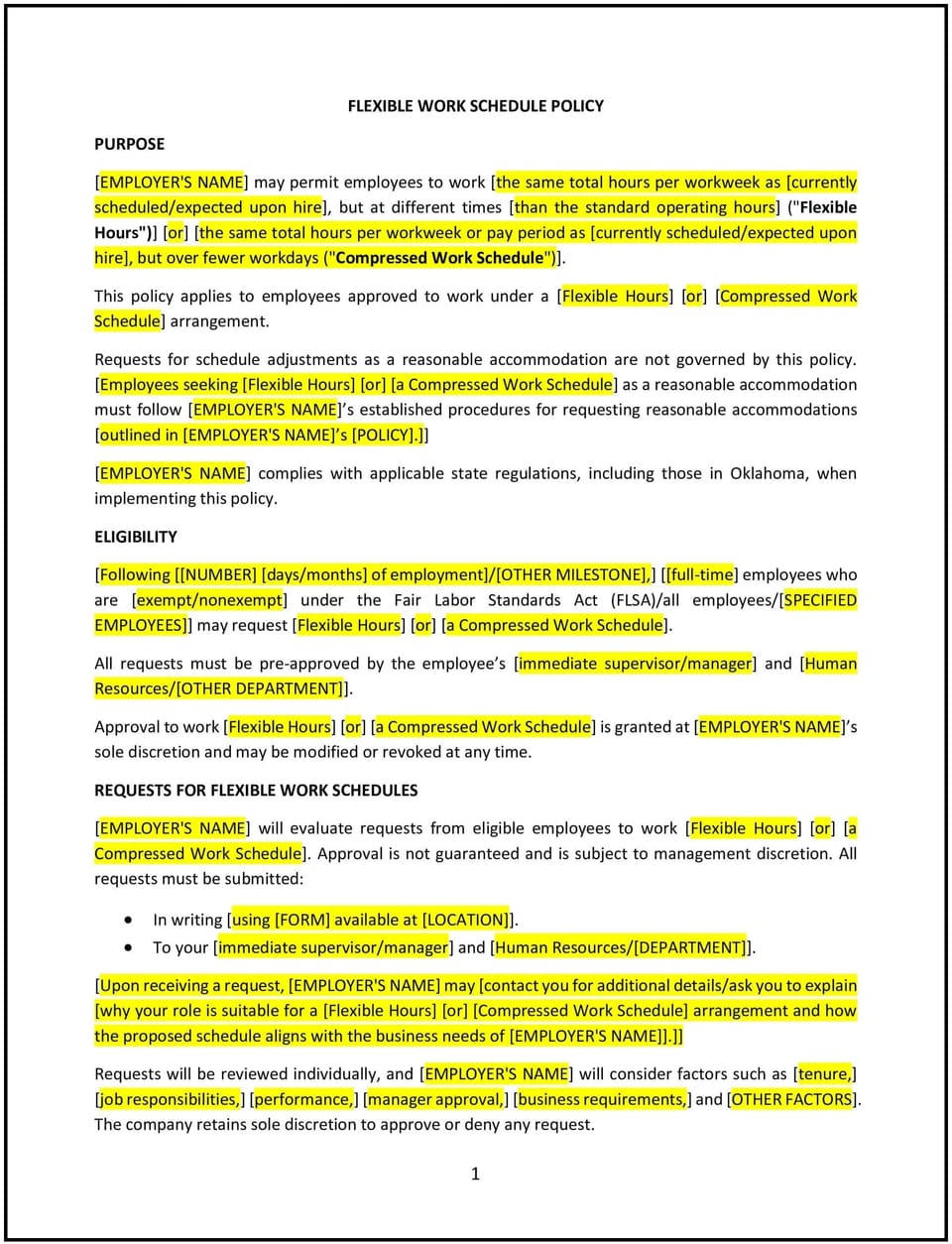Flexible work schedule policy (Oklahoma): Free template

Flexible work schedule policy (Oklahoma)
This flexible work schedule policy is designed to help Oklahoma businesses support work-life balance by allowing employees to adjust their work hours or location. It outlines eligibility, procedures for requesting flexible schedules, and guidelines for maintaining productivity.
By adopting this policy, businesses can enhance employee satisfaction, improve retention, and foster a more adaptable and productive workforce.
How to use this flexible work schedule policy (Oklahoma)
- Define eligibility: Specify which employees are eligible for flexible work schedules, such as full-time staff or those in certain roles.
- Outline options: Describe the types of flexible schedules available, such as remote work, compressed workweeks, or adjusted start and end times.
- Establish request procedures: Provide steps for employees to request a flexible schedule, including required notice and approval processes.
- Address productivity expectations: Clarify that employees on flexible schedules must maintain their productivity and meet performance standards.
- Train managers: Educate supervisors on managing flexible schedules effectively and ensuring fairness across teams.
- Review and update: Assess the policy annually to ensure it aligns with evolving workplace needs and employee expectations.
Benefits of using this flexible work schedule policy (Oklahoma)
This policy offers several advantages for Oklahoma businesses:
- Enhances work-life balance: Supports employees in managing personal and professional responsibilities, improving job satisfaction.
- Improves retention: Demonstrates a commitment to employee well-being, which can reduce turnover and attract top talent.
- Boosts productivity: Allows employees to work during their most productive hours, increasing efficiency and output.
- Fosters adaptability: Encourages a culture of flexibility and innovation, helping businesses respond to changing needs.
- Builds trust: Shows employees that the business values their time and contributions.
Tips for using this flexible work schedule policy (Oklahoma)
- Communicate clearly: Ensure all employees understand the policy and their eligibility for flexible schedules.
- Provide training: Educate managers on handling flexible schedule requests and maintaining team cohesion.
- Monitor performance: Track productivity and engagement to ensure flexible schedules are working effectively.
- Encourage feedback: Regularly seek input from employees and managers to identify areas for improvement.
- Update regularly: Review the policy annually to ensure it remains effective and aligned with business needs.
Q: How does this policy benefit businesses?
A: It enhances work-life balance, improves retention, and boosts productivity by allowing employees to work more flexibly.
Q: Who is eligible for a flexible work schedule?
A: Eligibility depends on the business’s policy, but it typically includes full-time employees or those in roles that can accommodate flexibility.
Q: What types of flexible schedules are available?
A: Options may include remote work, compressed workweeks, or adjusted start and end times, depending on the business’s needs.
Q: How are flexible schedule requests approved?
A: Requests are typically approved based on business needs, team dynamics, and the employee’s ability to maintain productivity.
Q: How often should businesses review this policy?
A: Businesses should review the policy annually or as needed to ensure it aligns with evolving workplace needs and employee expectations.
This article contains general legal information and does not contain legal advice. Cobrief is not a law firm or a substitute for an attorney or law firm. The law is complex and changes often. For legal advice, please ask a lawyer.


